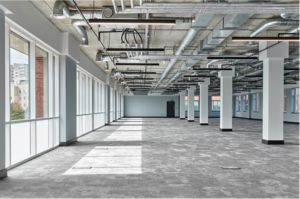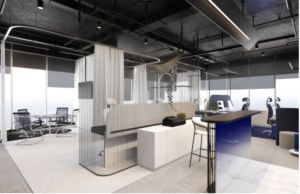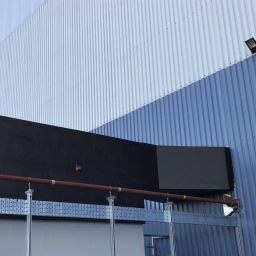Cat A and Cat B: If you are a landlord or tenant seeking to transform a building into an office, you would need a basic understanding of office fit-outs. Navigating the fit-out world with little to no knowledge of these terms could be quite difficult, especially for those unfamiliar with the construction and refurbishment of commercial property.
It’s hard to wrap your head around some terminologies used in the construction document presented to you. But you need to know what you are getting when you sign on those dotted lines.
No matter what type of fit-out you opt for, you will need accurate M&E estimating for the job. Here at Chase Estimating, we do just that. Lean on us when you need to use an estimating service.
So let’s dive in.
There are three basic types of fit-outs:
- – Shell and Core
- – CAT A fit-out
- – CAT B fit-out
Let’s find out the difference between a Shell and core, CAT A and a CAT B fit-out in this blog. But first off, let me explain what exactly a fit-out is?
What is a fit-out? , Cat A and Cat B
In simpler terms, “fit out” refers to the construction phase of preparing an interior area for use by the occupants – owner or tenants. It involves designing and transforming a concrete shell into a space that can be as functional as possible. This results in an area that is capable of meeting any need that its users may have.
In the construction industry, the shell and core, Cat A, and Cat B fit-outs are yet to be properly defined by an official body so their definitions are open to interpretation depending on who you speak to. So, always discuss/confirm with your landlord or contractor the level of finish they will provide. A landlord or contractor usually supplies the space as a Shell/Core or a Cat A fit-out, leaving it up to the tenants to work out the final interior design of the place as they see fit.
If you are negotiating a contract with your landlord or fit-out specialist, be sure to confirm what is and is not included. This way you will know what you are getting out of the contract.
What exactly is a Shell/Core?
The most basic internal framework of a facility is known as the shell and core. The shell is just a weatherproofed space with only the most basic facilities built in. The concrete and metal construction may seem complete from the outside, but basic building services such as lighting and others are yet to be installed. The features, such as the building reception, lifts, and communal bathrooms, may be completed as part of a Shell and Core fit-out. Risers including all M+E serving from centralised plant rooms / decks will usually be included but nothing extending onto the floor plates. Sprinkler systems are usually included as well.
If a contractor intends to hand over a project at this stage, you can be sure to see concrete floors without any polished finishing.
Below is a typical image of a shell and core finish. Very basic, no comforts in sight, just the bare bones and essential utility services.

Cat A Fit-Out, Cat A and Cat B
Cat A spaces (also known as Category A fit-outs) are the next progression after Shell and Core, and come with everything included in shell and core but with a basic finishing in the internal area. Cat A fit-outs are something a landlord looking to lease a facility would choose. If you look at a Cat A fit-out, it will be completely vacant, only including some of the most essential, functional elements. It is easier to sell it to tenants looking to design the place to their liking via a Cat B fit-out.
Mechanical and electrical utilities are installed in a Cat A fit-out. Painted perimeter walls, fitted lighting, lift lobbies, suspended ceiling, heating, raised flooring and reception spaces are all part of a Cat A project, but that’s about it. It’s all quite basic. It’s just a liveable space without any kind of customisation.
While a Cat A space may be habitable, it lacks the facilities required to make a workplace comfortable and appealing. It is an empty canvas for interior and office designers. Moving into a Cat A space right away is not usually recommended because you won’t have your unique rooms or cosy break-out areas to relax in with a cup of coffee. You’ll need to install a Cat B fit-out for this.
How a CAT A fit out might end up looking like. Note just basic finishes are included but also include Mechanical and electrical including pipes, ducts and insulation.
A Cat A fit-out typically includes the following:
Any work related to fire – like installation of fire alarms, and fire-fighting equipment, necessary according to the building regulations, is typically done in the Cat A stage.
Features like
- – Suspended ceilings and raised floors.
- – Blinds (window coverings) and stairs.
- – Toilet shells
- – Mechanical work and electrical services which extend out from the centralised risers out onto the floor plates, but may not include localised HVAC equipment such as fan coil units or AC units.
These features may not be visible to the end-user if they will be concealed above ceilings and behind walls. These works are typically taken for granted and are assumed to be in good functioning order.
Estimating CAT A fit outs naturally have a lot more scope and depth to them so more time and care is required.
Cat B Fit-Out:
Cat B (also known as Category B fit-out) is what comes after a Cat A fit-out. It provides all the facilities the occupants need to begin functioning in an area. A Cat B office fit-out is designed and created to suit your company’s and employees’ specific needs. It should have a correct balance of conference halls, workstations and breakout areas.
It takes a lot of effort to turn an empty canvas of a Cat A fit-out into a fully functional Cat B setting. The Cat B fit-out allows tenants to customise the place and make it their own. It gives businesses a say in planning and designing the interiors of their workplace in a way that would best reflect their culture and suit their staff. Hence, proper workplace consultation and planning is required, to know how best to design a Cat B setting.
The key is to make sure the space is fully functional, reflects the company culture and meets the needs of your employees. This isn’t just about choosing desks and furniture; it’s about making your office a place where your team wants to come to work, all while helping you attract clients and retain the business in your sector.
Bespoke designs that define your company culture should be included in a Cat B fit-out. In many cases, a tenant may need the landlord’s approval or a licence to alter the space before carrying out any alterations.
How a CAT B fit out might end up looking like. It’s the finished article, functional and great to look at, it’s ready to move into straight away for its occupants.
Here is what’s typically included in a Cat B installation:
- – Fully equipped kitchen.
- – Includes non-communal office facilities.
- – Meeting rooms, reception and breakout areas.
- – Furniture, workstations and any fittings and fixtures relating to it.
- – Brand-related decor.
- – Air conditioning and power outlets are being rerouted.
- – Bespoke lighting options.
- – Infrastructure and IT setup.
- – Intricate in design and branding.
Cat B is all about customising a new or existing office space to meet the needs and preferences of businesses and occupants. It’s similar to moving into a house and then personalising it with your favourite flooring, lighting, and decorations.
Estimating CAT B fit outs is the most challenging of the three as it is a fully fleshed out design which will have every single mechanical and electrical detail installed so the client can move in and use from day 1. Depending on the quality of the design, estimation can be difficult or can be straightforward but just more time-consuming.
If your looking for estimating software which can you can use to estimate projects yourself, then please contact us here as we have very favourable discounted rates with a leading estimating software provider here in the UK which is exclusive to us.
BREEAM
BREEAM do not sign up to the terms CAT A/B but use their own classifications which are –
Stage 1 – Fabric as well as framework: building envelope consisting of wall surfaces, roof covering, windows as well as flooring
Stage 2 – Core solutions: centralised mechanical as well as electric plant consisting of AHU’s, plant rooms, ductwork runs etc
Stage 3 – Local solutions: localised solutions consisting of lights & HVAC plants such as fan coil units.
Stage 4 – Internal layout: internal surfaces, furnishings, installations as well as hardware and equipment
Conclusion:
The definition of what a shell, core and a Cat-A is; varies from one landlord to another, as there is no consistent standard in the business. So, it’s important to know what’s included in your lease before you sign it.
Now that you know and have explored the fit-out world, you can point out the difference between the three. It will make it easy to determine which type of fit-out would work out best for you.
For Mechanical and Electrical estimating, no matter the fit-out you opt for, contact Chase Estimating. Our team of experienced estimators analyse and process your requests in detail to give you bespoke M&E estimating services. We are also specialists in the following areas:
- Thermal Insulation Estimating
- Plumbing estimating
- Ductwork Estimating
- AC Estimating







